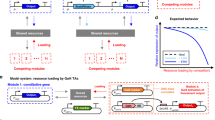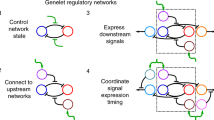Abstract
A central focus of postgenomic research will be to understand how cellular phenomena arise from the connectivity of genes and proteins. This connectivity generates molecular network diagrams that resemble complex electrical circuits, and a systematic understanding will require the development of a mathematical framework for describing the circuitry. From an engineering perspective, the natural path towards such a framework is the construction and analysis of the underlying submodules that constitute the network. Recent experimental advances in both sequencing and genetic engineering have made this approach feasible through the design and implementation of synthetic gene networks amenable to mathematical modelling and quantitative analysis. These developments have signalled the emergence of a gene circuit discipline, which provides a framework for predicting and evaluating the dynamics of cellular processes. Synthetic gene networks will also lead to new logical forms of cellular control, which could have important applications in functional genomics, nanotechnology, and gene and cell therapy.
This is a preview of subscription content, access via your institution
Access options
Subscribe to this journal
Receive 51 print issues and online access
$199.00 per year
only $3.90 per issue
Buy this article
- Purchase on Springer Link
- Instant access to full article PDF
Prices may be subject to local taxes which are calculated during checkout





Similar content being viewed by others
References
Monod, J. & Jacob, F. General conclusions: telenomic mechanisms in cellular metabolism, growth, and differentiation. Cold Spring Harb. Symp. Quant. Biol. 26, 389–401 (1961).
Glass, L. & Kauffman, S. A. The logical analysis of continuous, non-linear biochemical control networks. J. Theor. Biol. 39, 103–129 (1973).
Savageau, M. A. Comparison of classical and autogenous systems of regulation in inducible operons. Nature 252, 546–549 (1974).
Kauffman, S. A. The large-scale structure and dynamics of gene control circuits: an ensemble approach. J. Theor. Biol. 44, 167–190 (1974).
Glass, L. Classification of biological networks by their qualitative dynamics. J. Theor. Biol. 54, 85–107 (1975).
Glass, L. Combinatorical and topological methods in nonlinear chemical kinetics. J. Chem. Phys. 63, 1325–1335 (1975).
Savageau, M. A. Biochemical System Analysis (Addison Wesley, Reading, 1976).
Goodwin, B. C. Analytical Physiology of Cells and Developing Organisms (Academic, London, 1976).
Tyson, J. J. & Othmer, H. G. The dynamics of feedback control circuits in biochemical pathways. Prog. Theor. Biol. 5, 1–62 (1978).
McAdams, H. H. & Shapiro, L. Circuit simulation of genetic networks. Science 269, 650–656 (1995).
McAdams, H. H. & Arkin, A. Towards a circuit engineering discipline. Curr. Biol. 10, R318–R320 (2000).
Reinitz, J. & Vaisnys, J. R. Theoretical and experimental analysis of the phage lambda genetic switch implies missing levels of co-operativity. J. Theor. Biol. 145, 295–318 (1990).
Gardner, T. S., Cantor, C. R. & Collins, J. J. Construction of a genetic toggle switch in Escherichia coli. Nature 403, 339–342 (2000).
Elowitz, M. B. & Leibler, S. A synthetic oscillatory network of transcriptional regulators. Nature 403, 335–338 (2000).
Becskei, A. & Serrano, L. Engineering stability in gene networks by autoregulation. Nature 405, 590–593 (2000).
Hasty, J., Pradines, J., Dolnik, M. & Collins, J. J. Noise-based switches and amplifiers for gene expression. Proc. Natl Acad. Sci. USA 97, 2075–2080 (2000).
Smolen, P., Baxter, D. A. & Byrne, J. H. Mathematical modeling of gene networks. Neuron 26, 567–580 (2000).
Hasty, J., Isaacs, F., Dolnik, M., McMillen, D. & Collins, J. J. Designer gene networks: towards fundamental cellular control. Chaos 11, 207–220 (2001).
Hasty, J., McMillen, D., Isaacs, F. & Collins, J. J. Computational studies of gene regulatory networks: in numero molecular biology. Nature Rev. Genet. 2, 268–279 (2001).
Thattai, M. & van Oudenaarden, A. Intrinsic noise in gene regulatory networks. Proc. Natl Acad. Sci. USA 98, 8614–8619 (2001).
Simpson, M. L., Sayler, G. S., Fleming, J. T. & Applegate, B. Whole-cell biocomputing. Trends Biotechnol. 19, 317–323 (2001).
Becskei, A., Séraphin. B. & Serrano, L. Positive feedback in eukaryotic gene networks: cell differentiation by graded to binary response conversion. EMBO J. 20, 2528–2535 (2001).
Ozbudak, E. M., Thattai, M., Kurtser, I., Grossman, A. D. & van Oudenaarden, A. Regulation of noise in the expression of a single gene. Nature Genet. 31, 69–73 (2002).
Thattai, M. & van Oudenaarden, A. Attenuation of noise in ultrasensitive signaling cascades. Biophys. J. 82, 2943–2950 (2002).
McAdams, H. H. & Arkin, A. Stochastic mechanisms in gene expression. Proc. Natl Acad. Sci. USA 94, 814–819 (1997).
Hartwell, L. H., Hopfield, J. J., Leibler, S. & Murray, A. W. From molecular to modular cell biology. Nature 402, C47–C51 (1999).
Lauffenburger, D. A. Cell signaling pathways as control modules: complexity for simplicity? Proc. Natl Acad. Sci. USA 97, 5031–5033 (2000).
Palsson, B. O. & Lightfoot, E. N. Mathematical modeling of dynamics and control in metabolic networks. J. Theor. Biol. 113, 279–298 (1985).
Thomas, R. The role of feedback circuits: positive feedback circuits are a necessary condition for positive real eigenvalues of the Jacobian matrix, Ber. Besenges. Phys. Chem. 98, 1148–1151 (1994).
Thomas, R., Thieffry, D. & Kaufman, M., Dynamical behaviour of biological regulatory networks-I. Biological role of feedback loops and practical use of the concept of the loop-characteristic state. Bull. Math. Biol. 57, 247–276 (1995).
Ferrell, J. E. Jr Self-perpetuating states in signal transduction: positive feedback, double-negative feedback and bistability. Curr. Opin. Cell. Biol. 14, 140–148 (2002).
Keller, A. Model genetic circuits encoding autoregulatory transcription factors. J. Theor. Biol. 172, 169–185 (1995).
Ferrell, J. E. Jr Xenopus oocyte maturation: new lessons from a good egg. BioEssays 21, 833–842 (1999).
Ferrell, J. E. Jr Building a cellular switch: more lessons from a good egg. BioEssays 21, 866–870 (1999).
Aurell, E., Brown, S., Johanson, J. & Sneppen, K. Stability puzzles in phage λ. Phys. Rev. E 65, 051914-1–051914-9 (2002).
Bialek, W. in Advances in Neural Information Processing Vol. 13 (eds Leen, T. K., Dietterich, T. G. & Tresp, V.) 103–109 (MIT Press, Cambridge, MA, 2001).
Weiss, R. & Basu, S. The device physics of cellular logic gates. First Workshop on Non-Silicon Computing 〈http://www-2.cs.cmu.edu/~phoenix/nsc1/paper/3-2.pdf〉 (2002).
Weiss, R. Cellular Computation and Communications Using Engineered Genetic Regulatory Networks. Thesis, Massachusetts Institute of Technology (2001).
Guet, C., Elowitz, M., Hsing, W. & Leibler, S. Combinatorial synthesis of genetic networks. Science 296, 1466–1470 (2002).
Dunlap, J. Molecular bases for circadian clocks. Cell 96, 271–290 (1999).
Panda, S., Hogenesch, J. B. & Kay, S. A. Circadian rhythms from flies to human. Nature 417, 329–335 (2002).
Leloup, J. C. & Goldbeter, A. A model for circadian rhythms in Drosophila incorporating the formation of a complex between the PER and TIM proteins. J. Biol. Rhythms 13, 70–87 (1998).
Tyson, J. J., Hong, C. I., Thron, C. D. & Novak, B. A simple model of circadian rhythms based on dimerization and proteolysis of PER and TIM. Biophys. J. 77, 2411–2417 (1999).
Leloup, J. C. & Goldbeter, A., Modeling the molecular regulatory mechanism of circadian rhythms in Drosophila. BioEssays 22, 84–93 (2000).
Roussel, M. R., Gonze, D. & Goldbeter, A. Modeling the differential fitness of cyanobacterial strains whose circadian oscillators have different free-running periods: comparing the mutual inhibition and substrate depletion hypotheses. J. Theor. Biol. 205, 321–340 (2000).
Barkai, N. & Leibler, S. Biological rhythms: circadian clocks limited by noise. Nature 403, 267–268 (2000).
Vilar, J. M. G., Kueh, H. Y., Barkai, N. & Leibler, S. Mechanisms of noise-resistance in genetic oscillators. Proc. Natl Acad. Sci. USA 99, 5988–5992 (2002).
Smith, H. Oscillations and multiple steady states in a cyclic gene model with repression. J. Math. Biol. 25, 169–190 (1987).
Arkin, A., Ross, J. & McAdams, H. H. Stochastic kinetic analysis of developmental pathway bifurcation in phage λ-infected Escherichia coli cells. Genetics 149, 1633–1648 (1998).
Kepler, T. & Elston, T. Stochasticity in transcriptional regulation: origins, consequences and mathematical representations. Biophys. J. 81, 3116–3136 (2001).
Paulsson, J., Berg, O. G. & Ehrenberg, M. Stochastic focusing: fluctuation-enhanced sensitivity of intracellular regulation. Proc. Natl Acad. Sci. USA 97, 7148–7153 (2000).
Weiss, R. & Knight, T. F. in DNA6: Sixth International Meeting on DNA Based Computers (Leiden, The Netherlands, 2000).
Fuqua, C., Winans, S. & Greenberg, E. P. Census and consensus in bacterial ecosystems: the LuxR-LuxI family of transcriptional regulators. Annu. Rev. Microbiol. 50, 727–751 (1996).
Bassler, B. L. How bacteria talk to each other: regulation of gene expression by quorum sensing. Curr. Opin. Microbiol. 2, 582–587 (1999).
McMillen, D., Kopell, N., Hasty, J. & Collins, J. J., Synchronizing genetic relaxation oscillators by intercell signaling. Proc. Natl Acad. Sci. USA 99, 679–684 (2002).
Somers, D. & Kopell, N. Rapid synchronization through fast threshold modulation. Biol. Cybern. 68, 393–407 (1993).
Wang, D. L. in Proc. 15th Annu. Conf. Cognit. Sci. Soc. 1058–1063 (Lawrence Erlbaum Assoc., Hillsdale, NJ, 1993).
Ramachandra, M. et al. Re-engineering adenovirus regulatory pathways to enhance oncolytic specificity and efficacy. Nature Biotech. 19, 1035–1041 (2001).
Vogelstein, B., Lane, D. & Levine, A. J. Surfing the p53 network. Nature 408, 307–310 (2000).
Hasty, J., Dolnik, M., Rottschafer, V. & Collins, J. J. A synthetic gene network for entraining and amplifying cellular oscillations. Phys. Rev. Lett. 88, 148101-1–148101-4 (2002).
Novak, B. & Tyson, J. J. Modeling the control of DNA replication in fission yeast. Proc. Natl Acad. Sci. USA 94, 9147–9152 (1997).
Sveiczer, A., Csikasz-Nagy, A., Gyorffy, B., Tyson, J. J. & Novak, B. Modeling the fission yeast cell cycle: quantized cycle times in wee1−cdc25δ mutant cells. Proc. Natl Acad. Sci. USA 97, 7865–7870 (2000).
Chen, K. C., Csikasz-Nagy, A., Gyorffy, B., Novak, B. & Tyson, J. J. Kinetic analysis of a molecular model of the budding yeast cell cycle. Mol. Biol. Cell 11, 369–391 (2000).
Tegner, J., Yeung, M. K. S., Hasty, J. & Collins, J. J. Reverse engineering gene networks—integrating genetic perturbations with dynamical modeling. Proc. Natl Acad. Sci. USA (submitted).
Ptashne, M. et al. How the λ repressor and cro work. Cell 19, 1–11 (1980).
Acknowledgements
This work was supported by the Defense Advanced Research Projects Agency (DARPA), Office of Naval Research (ONR), National Science Foundation (NSF) BioQuBIC, the Fetzer Institute, and Natural Sciences and Engineering Research Council of Canada (NSERC).
Author information
Authors and Affiliations
Corresponding author
Rights and permissions
About this article
Cite this article
Hasty, J., McMillen, D. & Collins, J. Engineered gene circuits. Nature 420, 224–230 (2002). https://doi.org/10.1038/nature01257
Issue Date:
DOI: https://doi.org/10.1038/nature01257
This article is cited by
-
Engineering native biological complexity from the inside–out and outside–in
Nature Chemical Engineering (2024)
-
A synthetic population-level oscillator in non-microfluidic environments
Communications Biology (2023)
-
The Application Potential of Synthetic Biology in Microbial Communication
Current Clinical Microbiology Reports (2023)
-
Radical pairs can explain magnetic field and lithium effects on the circadian clock
Scientific Reports (2022)
-
Synthetic neuromorphic computing in living cells
Nature Communications (2022)
Comments
By submitting a comment you agree to abide by our Terms and Community Guidelines. If you find something abusive or that does not comply with our terms or guidelines please flag it as inappropriate.



